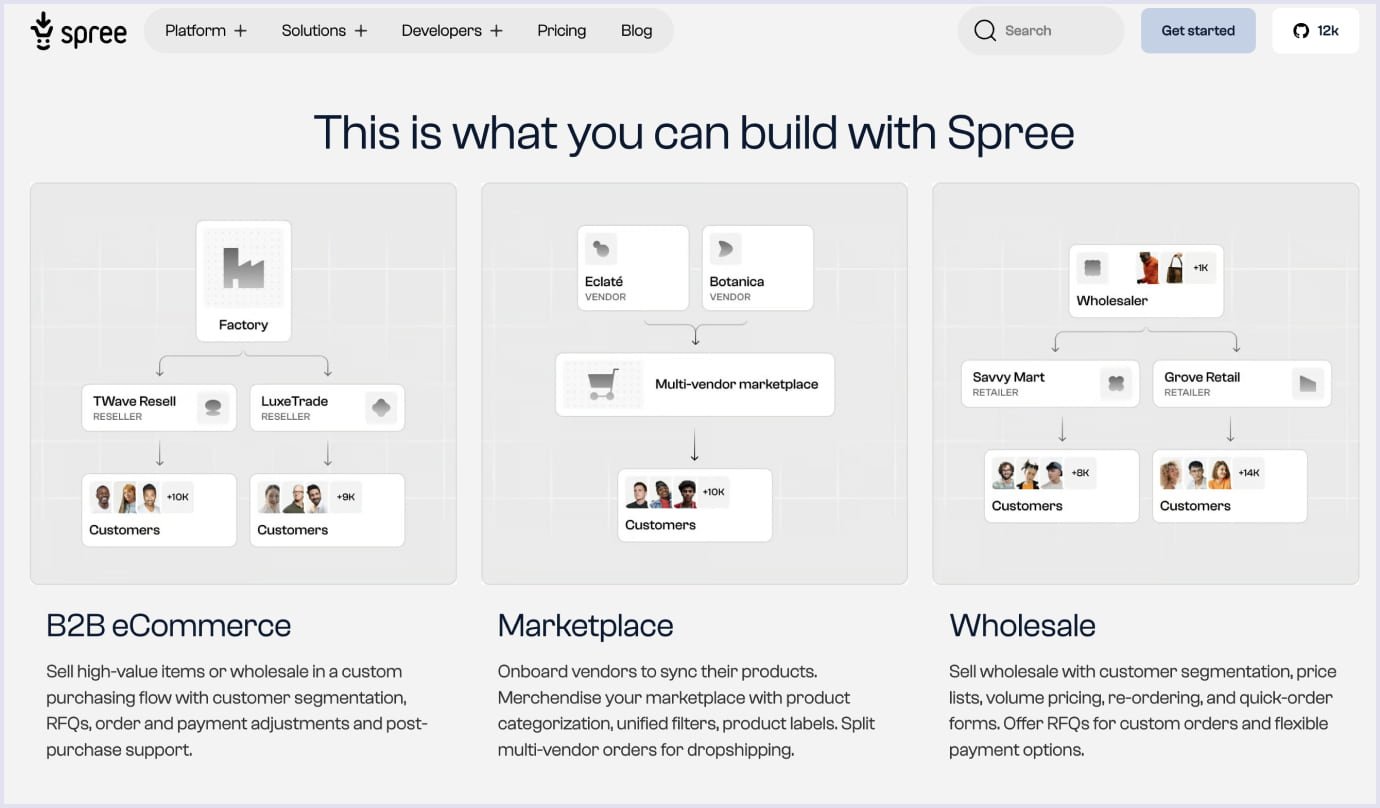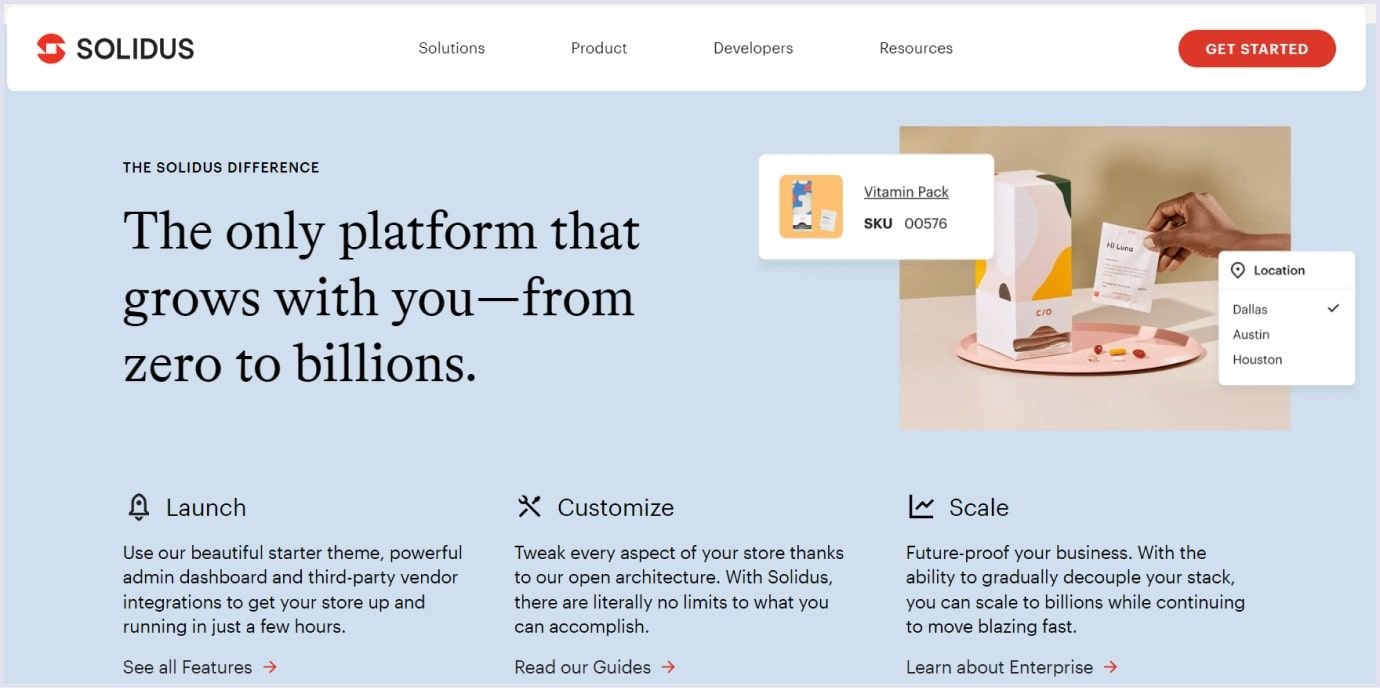Regarding the benefits of an ecommerce website for your customers, it’s a sound idea to build one. The platform will help your business reach customers, streamline operations, and evolve. Still, this evolution requires effort to start. So, how much does an ecommerce website cost?
In this article, our experts provide a detailed breakdown of how much it costs to build an ecommerce website. We analyze development approaches, stages, and helpful tools so you can plan your ecommerce website development ahead of time.
Let’s dive into it.
Key factors influencing ecommerce website cost
When you start your ecommerce website project, several factors will affect your development costs. Below, we outline the key aspects of ecommerce marketplace development and how they influence the cost.
Project complexity. This is the primary factor when it comes to the cost of building an ecommerce website. The more features your solution includes, the more resources it requires. Building your platform includes product discovery, UI/UX design costs, development, and support.
Development approach. If you choose custom development from scratch, it will cost you more than using pre-built components. On the other hand, choosing development with pre-built elements lowers development costs but limits customization capabilities. So, you get a low-cost ecommerce website, but scalability and customization might be challenging.
Tech stack and integrations. Choosing modern technologies and integrations helps you create a competitive solution. At the same time, it influences the cost of your website. Modern technologies can reduce the price. On the other hand, if you need third-party integrations, they can add up to the cost of ecommerce website development.
Maintenance and updates. As technologies and markets evolve, your website will need tweaks and updates. Moreover, continuous security monitoring is necessary to protect you against revenue losses. These aspects require additional costs.
Cost breakdown by development stages
Development deserves a more detailed overview as a factor in ecommerce website cost. Knowing the particular stages and their price will help you plan your budget. Let’s dive into the development stages that form custom ecommerce website development cost.
Planning and research
Custom software development starts with defining the commercial details of your website. At Codica, we recommend starting at this planning and research stage. So, our team helps you determine your goals, define your target audience, and describe your value proposition. Moreover, we can also provide a thorough analysis of your competitors.
If you build an MVP, the discovery phase should take 60 to 100 hours, with a cost estimate of $3,000 to $6,000 per hour at a rate of $50. More complex website versions take between 120 and 180 hours to complete.
At Codica, when the product discovery is over, you get a detailed business analysis of your solution. We also provide you with a feature description, clickable prototypes, and tech recommendations for implementation. Below is the video that outlines these deliverables in more detail.
Design and UX/UI
Once the ecommerce website plan is agreed upon and approved, designers start working on the prototypes initially created during the discovery. Based on the prototypes, designers create layouts that embody user experience with your website. After the details and features are considered, designers add visuals that enrich the user interface and reflect your brand identity.
At Codica, the design phase involves close cooperation of designers, project managers, and developers. Our team pays close attention to any suggestions or ideas you have regarding your project. Once the design is ready, our design team creates guidelines for the development team. This approach to UI/UX design services preserves your specifications and optimizes the development process.
The cost of this step depends on your project’s sophistication. Intuitive and accessible UI/UX design for an ecommerce website can be created within 120-180 hours. The estimate for this phase is $6,000 - $9,000.
Front-end and back-end development
Custom web development covers both sides of an ecommerce website, client-side and server-side. Over the years, we have chosen the best technologies for your project. They help us ensure that your website’s front-end part is appealing and the back-end part smoothly runs operations.
We leverage JavaScript, TypeScript, React, Next.js, and Material UI for the front-end part. They have proven themselves reliable tools for creating modern interfaces with accessibility in mind. The table below shows estimates for developing your ecommerce solutions in the front-end part.
| Custom ecommerce website complexity | Hours for developing the front-end part | Cost |
| Simple | 200 | $10,000 |
| Medium | 350 | $17,500 |
| Advanced | 450 | $22,500 |
On the other hand, the back-end ensures smooth operation of your ecommerce platform. So, for this, we use Node.js, NestJS, Serverless, Ruby, Ruby on Rails, PostgreSQL, Elasticsearch or Algolia, Redis, and AWS. Check the table below for estimates of the back end of a custom ecommerce website.
| Custom ecommerce website complexity | Hours for developing the back-end part | Cost |
| Simple | 300 | $15,000 |
| Medium | 500 | $25,000 |
| Advanced | 650 | $32,500 |
Testing and launch
Checking a custom solution for errors is a must for delivering a robust solution that your customers will enjoy. Thus, we thoroughly test your ecommerce platform before launch. We perform usability tests starting from test-driven development to ensure your website’s continuous operation.
Our QA testing services include functionality, performance, security, and user acceptance tests. Codica’s quality assurance professionals identify and fix bugs to ensure the website’s proper work. The cost of this stage varies between $4,000 and $6,000.
Maintenance and updates
Once you’ve deployed your ecommerce website, it needs continuous updates and support. Thanks to our DevOps services, we ensure a safe environment for monitoring your website. Our DevOps engineers ensure the smooth and stable work of your custom ecommerce platform. So, in the long run, you protect your solution against cyber attacks and save costs.
For an ecommerce website, maintenance and support expenses can range from $1,000 to $4,500 when working with a software consultancy. On the other hand, if using a website builder, support costs will range from $0 to $3,500 yearly.
Now, let’s frame everything we’ve broken down into stages into one cohesive table. Once again, note that the mentioned prices are based on $50 per hour, which is commonplace throughout Easter Europe.
| Service | Hours | Cost |
| Product discovery | 60 to 120 hours | $3,000 to $6,000 |
| UI/UX design | 120 - 180 hours | $6,000 - $9,000 |
| Front-end and back-end development | 400 - 500 hours | $20,000 - $25,000 |
| Testing and launch | 80 - 120 hours | $4,000 - $6,000 |
| Maintenance and updates | 20 - 90 hours | $1000 - $4,500 |

Comparison of ecommerce development methods
Generally, you can select between two options in website building: custom development and development with frameworks. Let’s consider them in more detail to see how they influence the average cost for an ecommerce website.
Custom development
If you turn to us for custom software development, we are eager to help you by following the latest industry standards. What will you get? We support you from product discovery to continuous support. Our team provides constant communication and adjustments as the product passes through development.
Custom features you wish to include will be developed. So, your solution will stand out and bring value to your customers. As we recommend starting from a minimum viable product, the ecommerce website cost will range between $25,000 - $50,000.
Development frameworks
Ecommerce development frameworks are helpful in ecommerce website development. They have prebuilt functionality to create a low-cost ecommerce website yet also provide space for customization.
Development with a framework will cost less than custom development from scratch. So, the average cost for an ecommerce website will be around $10,000 - $15,000. You also get more space for flexibility and scalability than with ecommerce platforms offering pre-built solutions.
Which ecommerce development frameworks do we recommend? Here is a list with a brief description.
Spree Commerce
Specializing in Ruby and Ruby on Rails development, we recommend Spree Commerce solutions for their undeniable advantages. It has a modular structure that allows developers to choose and customize features if needed. Spree Commerce has many plugins and integrations that support ecommerce features.

Source: Spree Commerce
Vendure
It is a headless ecommerce framework based on TypeScript, Angular, Node.js, and NestJS. It provides a vast feature set to help you customize your ecommerce website as you wish. It works for companies of any size. Startups, business-to-business enterprises, and Fortune 500 companies entrust their operations to be based on this tool. Thanks to top-notch developer experience, you can create your ecommerce website and save costs.
Solidus
It is another ecommerce framework based on Ruby on Rails. The tool helps businesses of all sizes and across various industries. Among prominent features are segmented pricing, rich taxonomies, and personalization quizzes. Stock and tax payments management add to the overall versatility of the technology. The features ensure flexibility and speed in order processing, returns, and other ecommerce operations.

Source: Solidus
Medusa
The modular structure of this framework helps you manage customizations and choose suitable features. The platform offers pricing, order, customer, payment, and other modules to cover the necessary ecommerce processes. For example, Medusa helps process 5,000 orders daily. The tool is designed to create ecommerce websites, B2B stores, online marketplaces, and more.
Custom ecommerce development: cost analysis
If you want your ecommerce website to meet changing market demand, custom development is the way to go. Your tech partner will leverage modern technologies to make your platform adaptable to your customers’ needs, tech advancements, and market trends.
Let’s break down the custom development by features for the basic ecommerce website cost.
Cost estimation by functionality
If you partner with a software development firm, they will provide you with a basic ecommerce website cost estimate that includes a breakdown by features. For instance, the product catalog and shopping cart cost less, whereas more complex features like payment gateway, advanced search, and complex management systems require more development effort. Here’s a short overview of features you may need to add to your ecommerce solution.
- Product catalog. Let’s discuss what basic features should be included in your ecommerce website. It starts with a product search, so your catalog should be eye-catching and informative. Add images and product descriptions, reviews, and pricing to help your customers search for what they need fast.
- Shopping cart. A shopping cart is another basic feature of an ecommerce website. It helps your customers add, edit, and remove items before checkout. Make it simple and easy to use for your customers so your cart abandonment rate is as low as possible.
- Third-party payment integration. Third-party integrations include shipment, marketing automation tools, and payment gateways. Try to choose reliable and simple payment systems. For example, we recommend adding Stripe to your site. It has rich currency coverage and provides for easy and smooth payments.
- Personalization features. Adding personalization features will improve customer experience with your platform. Today, ecommerce websites use personalization to offer related products and help shoppers search for necessary items.
- Advanced product search and filtering. An efficient search functionality enables customers to quickly find products. It often includes filters by category, price, rating, brand, etc., and sometimes an autocomplete feature for quick searches. Besides, there’s a plethora of tools that can enhance the process with AI.
Once again, let’s put all those numbers in one place, namely, a table, this time, outlining pricing for each particular feature your ecommerce solution may need.
| Features | Time, hours | Cost ($50/h) |
| Design | ||
| UX development | 64 | $3,200 |
| UI development | 96 | $4,800 |
| Architecture | ||
| Project setup | 16 | $800 |
| DB structure | 32 | $1,600 |
| Integrations | ||
| Payment (Stripe or PayPal) | 64 | $3,200 |
| Shipment (Shippo) | 32 | $1,600 |
| Main functionality | ||
| Authorization and security | 32 | $1,600 |
| User profiles | 42 | $2,100 |
| Homepage | 64 | $3,200 |
| Search and filters | 48 | $2,400 |
| Product page | 42 | $2,100 |
| Reviews & ratings | 32 | $1,600 |
| Checkout | 64 | $3,200 |
| Notifications | 32 | $1,600 |
| Inventory management | 42 | $2,100 |
| Buyer panel | 120 | $6,000 |
| Vendor panel | 120 | $6,000 |
| Admin panel | 120 | $6,000 |
| Wishlist | 32 | $1,600 |
| Non-development activity | ||
| Project management | 64 | $3,200 |
| Quality assurance | 96 | $4,800 |
| Code review | 48 | $2,400 |
| Total | 1302 | $65,100 |
Examples of custom solutions
We suggest an overview of several examples to understand how custom development helps ecommerce websites stand out. Here are some ecommerce examples from our completed projects.
Domain sale website
This platform for selling domains allows you to sell and buy domain names easily and quickly. Our part was to redevelop the Portfolio section. It needed optimization to handle thousands of domain names fast. As a result of our optimizations, the website can now load a page with 1,000 domains in 2 seconds. The design is helpful so you can find, select, buy, and sell domain names easily.
Custom ecommerce solution
A custom multi-vendor website for B2C (business-to-business) and C2C (consumer-to-consumer) sectors provides a rich product catalog. Thanks to our custom software development services, the website serves three parts. They are Local (B2C), World (C2C), and Connect (C2C). Customer-oriented search helps find products within the catalog. The solution also features an interactive sign-up form and a full-featured admin panel.
Boat selling website
This platform, named Tradeaboat, is a favorite place to sell boats and equipment in Australia. The task was to redesign the boat sale website and make it user-friendly. We took care of the brand style and created a vivid and convenient interface as part of our website redesign services. Improvements also include the integration of inventory management systems and enhanced ad features. Thus, private sellers and dealers increased their listings’ visibility.
Check the table below for a cost range for custom development of ecommerce solutions.
| Ecommerce website project | Timeline to complete | Cost, $ |
| Domain sale website | 4-5 months | 40,000 - 55,000 |
| Custom ecommerce solution | 4-6 months | 50,000 - 65,000 |
| Boat selling website | 3-4 months | 35,000 - 50,000 |
Affordable custom development options
If you want a customizable and scalable solution for a moderate cost, check the overview below. Here, we share how you can optimize your expenses yet get a website that meets your business goals.
Utilizing open-source frameworks
There are various prominent frameworks industry offers, including the ones covered earlier. The main reason for using them is their flexibility and a plethora of ready-made components that allow you to build a low-cost ecommerce website.
Besides, even prefabricated elements can be easily customized, allowing you to scale your platform, gradually introducing new features as you see fit. So, if you want a simple solution, you might consider a framework as an option for your start.
Work with trusted outsourcing contractors
The search for a reliable IT vendor partner takes effort but saves you resources in the end. To find a reliable software development team, search reviews on trusted platforms. They include Clutch, Glassdoor, and Owler. For example, Codica has won several Clutch awards as a top developer consultancy.

Minimizing hosting and domain costs
When choosing among hosting options, consider the services and pricing of hosting providers. If you start small, you may choose shared hosting. Later, you might transition to virtual private servers (VPS) or cloud hosting, such as AWS (Amazon Web Services), Azure, and Google Cloud.
We offer hosting with AWS because the platform is robust, versatile, and provides the necessary features for any scale. AWS offers a Free Tier for new users, which includes limited usage of services (e.g., 750 hours per month of Amazon EC2 for one year, 5 GB of S3 storage). If usage is minimal and remains within these limits, hosting costs can effectively be $0.50 or even $0 for some months.
However, if you exceed the Free Tier, monthly costs vary widely. While ultra-low costs like $1-$3 per month are possible, they generally apply to the smallest instances (e.g., EC2 t4g.micro or low-level S3 storage). Realistically, costs are usually higher, especially if your platform needs more storage, bandwidth, or processing power. For many small applications, costs often start around $5 to $20 per month and can increase depending on specific resource needs.
Effective project management
When managing a project, the best choice is a practice that allows for flexibility and an iterative approach. The agile technique proved its efficiency for projects of any size. So, if your development partner chooses an agile approach to building your project, you get efficiency and save costs.
For example, the agile approach at Codica allows our teams to coordinate our progress. We maintain efficient communication and involve you in the process from the very start. Agile creates room for flexibility, so any changes and adjustments are introduced as you need them.

Implementing automation
Developers can automate testing and deployment tasks. Automation helps them make the processes faster and more accurate. So, developers save time and costs for repetitive tasks.
Automated monitoring also saves you costs. Monitoring processes help prevent vulnerabilities and revenue losses due to breaks in operation or security breaches.
Wrapping up
Cost estimates for an ecommerce website include many factors. If you consider custom development from scratch, it will take more resources. On the other hand, building a solution with a framework lowers the average cost for an ecommerce website. The ultimate choice depends on your business needs.
If you have an ecommerce website project in mind and want to discuss its cost, contact us. We are eager to understand your project details and provide you with a free estimate.

